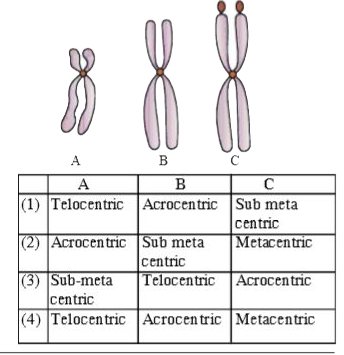Centromere is that part of chromosome where
Nucleoli are formed
Crossing over takes place
Chromatids are attached
Nicking occurs
The correct Answer is:C
Step by step video, text & image solution for Centromere is that part of chromosome where by Biology experts to help you in doubts & scoring excellent marks in Class 12 exams.
Topper's Solved these Questions
- BOOK - DINESH PUBLICATIONCHAPTER - CHROMOSOMAL BASIS OF INHERITANCEEXERCISE - Check Your Grasp45videos
CHROMOSOMAL BASIS OF INHERITANCE
- BOOK - DINESH PUBLICATIONCHAPTER - CHORDATA- PROTOCHORDATAEXERCISE - CYG7videos
CHORDATA- PROTOCHORDATA
- BOOK - DINESH PUBLICATIONCHAPTER - COELENTERATA AND CTENOPHORA (OR CNIDARIA AND ACNIDARIA)EXERCISE - CYG9videos
COELENTERATA AND CTENOPHORA (OR CNIDARIA AND ACNIDARIA)
Similar Questions
Knowledge Check
- Question 1 - Select One
Centromere is a part o f:
ARibosomesBMitochondriaCchromosomesDendoplasmic reticlum - Question 2 - Select One
Centromere is a part of chromosomes which helps in the
ADivison of centrosomesBFormation of spindle fibresCMovementof chromosomesDFormation of nuclear spindle - Question 3 - Select One
If the centromere is terminal , the chromosome is
AMetacentricBSubmetacentricCTelocentricDAcrocentric
Identify the type of chromosome with respect to centromere position :-
 View Solution
View SolutionWhat is a centromere? How does the position of centromere form the basis of classification of chromosomes. Support your answer with a diagram showing the position of centromere on different types of chromosomes.
View SolutionAssertion: During anaphase-II, the chromatids of a chromosome separate.
Reason: Centromere of a mitotic chromosome divides during anaphase.View SolutionThe chromosomes can be divided based on the position of the centromere. A certain chromosomes appears 'L' shaped during the anaphase stage and has centromere slightly away from the middle of the chromosome. Such a chromosome will be
View SolutionA karyotype is used to study
I) Number of chromosomes
II) Position of centromere
III) Position of chromosome
IV) Length of the arms
V) Secondary constrictionView Solution

